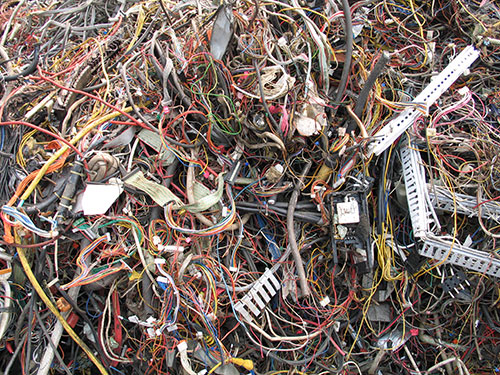Can we keep up with e-waste?

I'm glancing out my front office window as I mull this post, contemplating whether or not to bring in my garbage cans since the waste management crew has apparently again worked a schedule counter to the one published by my town. Last week, they skipped the Monday after Christmas, so you can imagine the items decorating our street until most of us dragged everything back in again. Today, I can see the evidence of some inspired New Year's Day closet-purging.
While my neighbors seem to have gotten better about trying to discard old appliances and electronics devices, finally responding to the laws here in New Jersey regarding such stuff, I'm nonetheless thinking about electronic waste this week, as the holiday season ends and the gadget-mania inspired by the forthcoming Consumer Electronics Show gets ready to begin. I am steeling myself for the onslaught.
A report released right before the New Year suggests that the amount of end-of-life electronics created by humans will more than double during the next 15 years. Its estimate suggests that this stuff will amount to 14.9 million tons by 2025, or an amount that would take up 1.47 million cubic feet. That compares with about 6 million tons and 676 million cubic feet as of 2010.
The thing is, we aren't creating the capacity to recycle or refurbish cast-off electronics as fast as we are creating that e-waste or e-scrap.
The capacity of responsible electronics recycling processors should rise from about 1.1 million tons in 2010 to 7.9 million tons annually by 2025. That is just as little more than half of the total amount being generated, which means that landfills and emerging nations will still be overloaded with items that really shouldn't be diverted there, according to the Pike Research report.
A separate report released in December, this one worked up by SBI Energy, provides some more perspective on the topic. Right now, e-waste accounts for less than 3 percent of the total solid waste stream, according to the company's "E-Waste Recycling and Reuse Services Worldwide" report. Collection services should triple by 2020 from a market value of about $6.8 billion in 2010. China and India have the largest market shares, which is something we need to watch carefully, since both countries have a poor history when it comes to recycling e-waste responsibly.
All this points up the need for a more active legislative agenda regarding electronic waste. Right now, about half the states have laws regarding handling, but they really can't do much about whether collected items are eventually shipped other than try to follow the trail and be transparent about it. There has been some federal legislation proposed, but given how ineffectual the current Congress is at passing anything, one shouldn't expect all that much progress.
Still, the electronics industry has vowed to do a better job at all this, which could help spur action. Back in April 2011, the Consumer Electronics Association's eCycling Leadership Initiative pledged to collect 1 billion pounds of electronics by 2016. Again, though, that doesn't account for all the stuff that is being created.
In my mind, we need to put a stronger emphasis not just on recycling but on two other areas:
- Design innovation. Especially ideas have recycling and refurbishment in mind from the beginning, maybe a strong emphasis on systems that can be upgraded to faster and better within their original chassis. After all, you remodel homes, why not computers?
- Reuse efforts. There are some great donation and reuse programs that direct older systems to worthy causes or into the education area; these causes should get a lot more visibility than they do. We also need to find a way to scale them more elegantly.
- Reclamation. The SBI Energy report notes that many of the materials found in electronics components -- especially lead, copper and gold -- could command some serious value and pose an alternative market to mining for this materials anew.
